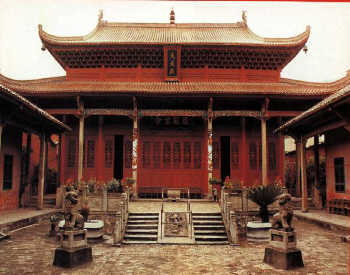
The Confucian temple
In feudal society, Confucius had always enjoyed the great respect of the ruling class as well as the rest of society. Temples officially built for worship became Confucian temples in various localities. The largest Confucian temple is inQufu, his home town, and most of the extant buildings were built in the Ming and Qing dynasties under imperial family guidance, demonstrating the attention paid by the Supreme rulers to Confucianism.
The Confucian temple sits in the north and faces south. It is about1 40 meters wide, and more than 600 meters long stretching from north to south. It is narrow, deep and long. The front gate of the Confucian temple is just opposite the south gate of the county seat. Counting from north to south, the whole temple is composed of several courtyards. The first three courtyards lead the way, and behind the main and middle gates of the fourth courtyard is the main part of the Confucian temple. Inside the gate there is the large Loukui Study for storing books. The fifth courtyard is elongated from east to west. There is a road leading to the main road of the city. Inside the courtyard are 13pavilions housing tablets of various dynasties. The sixth courtyard comprises three routes--left, middle and right, with the middle road as the main one. The Xing(apricot) Altar within Dacheng Gate symbolizes the place where Confucius gave lectures. The Chinese hip-and-gableroofcovered with a multi-eaved cross ridge looks very good. Dachengdian Hall is the heart of the Confucian Temple. The stone eaved pillars are covered with carveddragons. The multi-eaved Chinese hip-and-gable roof is of high specifications. When a grand worship ceremony is held on the wide platform in front of the hall, dance music is played. Confucian disciples and past scholars are worshipped in the east and west corridors of the courtyard. Behind the courtyard is a bedding hall where wife of Confucius was worshipped. The middle route of the seventh courtyard is Shengjidian Hall, stored with picture stones recording the deeds of Confucius.

Copyright ©1999-2011 Chinanews.com. All rights reserved.
Reproduction in whole or in part without permission is prohibited.